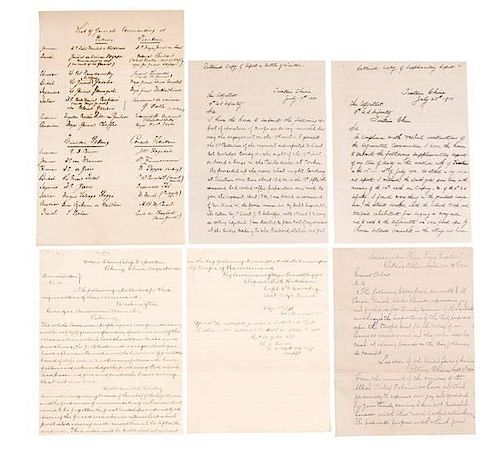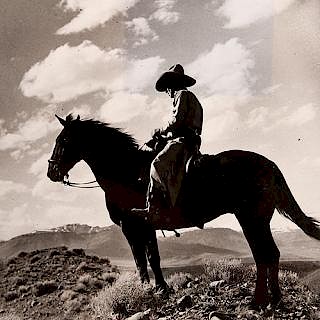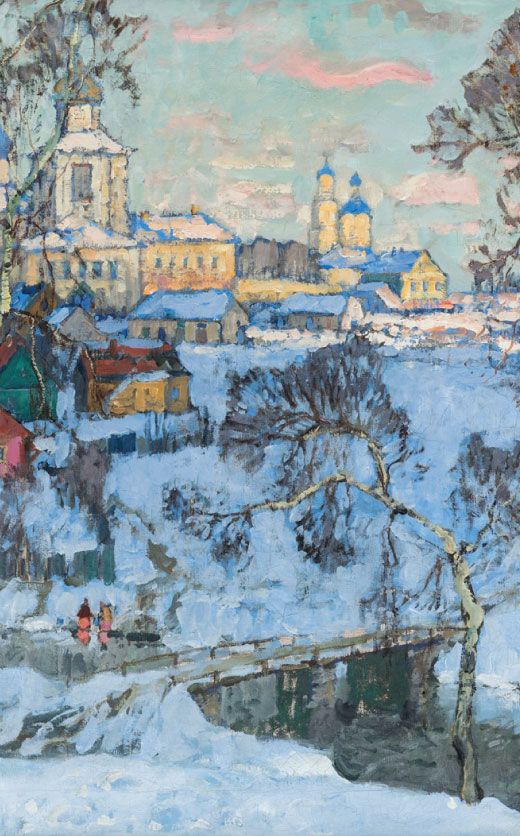M.C. Foote, 9th US Infantry, Archive Documenting Service during the Boxer Rebellion in China, Plus Later Correspondence, 1900-1905
About Seller
6270 Este Ave.
Cincinnati , OH 45232
United States
With offices in Cincinnati, Cleveland and Denver, Cowan’s holds over 40 auctions each year, with annual sales exceeding $16M. We reach buyers around the globe, and take pride in our reputation for integrity, customer service and great results. A full-service house, Cowan’s Auctions specializes in Am...Read more
Two ways to bid:
- Leave a max absentee bid and the platform will bid on your behalf up to your maximum bid during the live auction.
- Bid live during the auction and your bids will be submitted real-time to the auctioneer.
Bid Increments
| Price | Bid Increment |
|---|---|
| $0 | $25 |
| $500 | $50 |
| $1,000 | $100 |
| $2,000 | $250 |
| $5,000 | $500 |
| $10,000 | $1,000 |
| $20,000 | $2,500 |
| $50,000 | $5,000 |
| $100,000 | $10,000 |
About Auction
Jun 12, 2015 - Jun 13, 2015
Cowan's Auctions dawnie@cowans.com
- Lot Description
Lot of 125+ items, featuring 3 short journals, at least 100 official documents, letters, telegrams, and more, some with multiple pages, maps, newspapers, books, and pamphlets.
The Boxer Rebellion/Uprising/Movement took place in China 1899-1901, although its origins have been traced to the Treaty of Tientsin (Tianjin) and Convention of Peking in 1860 after the Second Opium War. The treaties established legations for most European and American nations, and granted foreign missionaries the freedom to preach anywhere in China. Over the next couple decades the Christian community grew. By 1897-1898 a series of natural disasters - drought, flood, etc. - helped to feed discontent. China had a long history of secret societies. In the northern province of Shandong, the Righteous and Harmonious Fists, or Boxers United in Righteousness arose. They practiced some martial arts (hence, "boxers") and spirit possession. Several early leaders had visions suggesting that the causes of the problems in China were foreigners, especially Christians.
In 1898 Christians in Liyuatun Village who had purchased and converted a temple to the Jade Emperor into a Catholic church were attacked. This, of course, outraged the foreign governments. There were many moves and counter-moves, with Chinese officials sometimes supporting one group, sometimes supporting others. Violence increased, and the foreign diplomats requested soldiers to defend the legations. In May 1900 over 400 navy troops from eight countries came to Beijing setting up defenses around the missions. Within a month, the legations were under siege, and on 12 June the Empress Dowager declared war against all foreign powers. The foreign navies had started building their presence along the northern coast a few months earlier. The so-called "Eight Nation Alliance (Austria-Hungary, France, Germany, Italy, Japan Russia, the United Kingdom, United States) were commanded by British Lieut. Gen. Alfred Gaselee. America was able to send a sizeable contingent since there were troops stationed in the Philippines who had just "won" the insurrection there. The American action was known as the "China Relief Expediton." Captain Morris C. Foote was among those who came from Manila to Tientsin. One American who was trapped in Tientsin, in the foreign sector, was future president Herbert Hoover and his wife. The Alliance captured Tientsin on 14 July, and used it as a base from which to advance on Beijing. They began on 4 August and reached Beijing on 14 August.
The materials collected by Morris C. Foote include the usual official materials - orders, notes, letters, etc. The lot includes a binder with nearly 70 such items, many of them with multiple pages. A second binder has four letters from his son, Francis, 33 telegrams and cablegrams, 17 business/calling cards, 10+ other letters, including one to his wife, printed orders, etc.
There are several journals and notebooks. In a small pocket notebook, 2.5 x 4 in. leather, is a two-page manuscript note in center with
Cable Nagasaki to Philadelphia / 3.66 mix aboard / Nagasaki to Taker 7 / Col. Bower Eng. Sign Corps / Capt. Shaw US National / 3 PM / Thurs. 12th & Fri. 13th / Reported to Lt. Col Coolidge / Eveng of the 12th , Thurs on river Peiho, barge reached / Tientsin about 10 am / Fri 13; Went with 9 inf. Hdqrs, cooked dinner – at 2p.m. I was ordered out with two Co’s of the 9th, Capt Sigworth USA & Schoffield, to the Japanese bridge to hold that point & communicate with Col. Bowers of the British Sig Corps at his station & Capt. Shaw of the US Marine acted as my guide. Established post at Bridge & at 3 pm. Reported to Col. Bower regard situation, had supper with our marine Officers at their Hdqrs at 4p.m. & returned to the Jap Bridge – Remained at bridge all night , with my Co. & 1 at RR station. / Sat. 14th Withdrew 1 Co. reported at Reg Hdqrts. Went into walled city of Tientsin with 1 Co at 9:50 am. Remained all day.
Journal, 4 x 6.5, leather – seems to be mostly 1900, but other random pages – 1898 – Aug. 27, 1904 Inside front pastedown –Morris Cooper Foote / Captain 9th U.S. Infty / Major 9th U.S. Infty. Aug. 11th? 1898 / Lieut. Co. Feby 2, 1901 / Colonel 28th Infty April 1902 / Grig. General Feby 18 1903 / Retired Feby 19th 1903. Loose paper inside with German phrase “cheat sheet” – Where can we get lunch / Where do we change cars / etc.
July 17 (1900) Foote sent official report to AG, Essentially the same info as above, but more details on 14th – when they went into the city, was ordered to report to Col. Meade of the USMC. I did so finding a portion of the city on fire, and was fired upon by Chinese Soldiers concealed in the houses. I directed Lieut Schoeffel to dislodge these men, which he did in a very gallant manner, having to fire some of the buildings in order to do so. After this work was accomplished I found Col. Meade and reported. I then moved into the South East Quarter, having to march around n the city wall to get there, the narrow streets being impassable on account of the fires raging throughout that part of the city. About 1 p.m. I occupied buildings adjoining an Ordnance depot. The other Companies of my battalion joined me in the evening.
Supplementary report dated July 25 summarizes this report, and adds: I am confident that no other American soldiers were in the city that day, and that no looting was done by them, though it seemed to be a general thing among the other troops of the allied forces. On the evening of the 14th three other companies of my Battalion come in and reported to me. I kept patrols up during that night, and preserved order as much as possible in our section. ON the 15th I was informed that there was a treasury containing a large amount of silver in the American section immediately adjoining the Japanese quarter, I at once sent a guard there but found it had been burned, a guard was placed over the ruins and subsequently a large amount of silver was taken from the vaults and turned over to the officer in command of the U.S. Marine force. I collected coolies and buried the dead Chinese soldiers all day on the 15th, patrolled our part of the city, and protected the inhabitants as much as possible. From all I could see and ascertain the English, French, and Japanese soldiers looted the city for some time, without any restriction in their sections, and undoubtedly some of the Chinese people plundered also. Very little if any of this was done by the U.S. Infantry troops. This may not have been entirely true. Some of the Chinese plundering has been interpreted as revenge for earlier depredations by Boxers.
A typed letter in the collection from Headquarters China Relief Expedition, Peking, China, November 2nd, 1900, to the Secretary of the Provisional Government in Tientsin informs them:
Sir – I have the honor to inform you that Major Morris C. Foote, 9th Infantry, Commanding U.S. Forces in Tientsin this winter, is designated to represent the United States on the council of the Provisional Government…. (Signed) Adna R. Chaffee, Major General, U.S.V. Commanding U.S. Forces in China.
More items in the archive include: Membership in the Military Order of the Dragon, Jan. 1, 1901, Tientsin Club, other fraternal organizations. A telegram from Adna Chaffee, Feb. 8, 1901, congratulating Foote on his promotion (this would be to Lieutenant Colonel).
Then came the letter on Consular Service USA letterhead, Tientsin, China, July 20th 1901:
My Dear colonel Foote,
A short time ago about one hundred people from a village near Tientsin approached my office with a band of music and a banner which I am sending you by U.S. Mail Today. They made me the recipient for you. Speeches were made by the dignitaries of the village and of course I made one in return. It is not necessary to repeat all that was said, but I will acknowledge that the joke is on me, for before departure the coolies who carried the banner struck me for $300 cumsha, which I meekly parted with. The banner was mounted on a large frame of wood, the wood being at least 3 inches thick, and weighted perhaps 200 pounds. I concluded that I could not send frame and all by post so stripped it off and send the cloth alone…. The name of the village is on the banner. They seemed to be very much in love with you and I am sorry that you was [sic] not present to enjoy the occasion… Signed J.W. Ragsdale.
Foote collected newspapers, prints:
Broadsheet, 15 x 20 in. Peking and Tientsin Times, Vol. VII, No. 48, Sat. April 6th, 1901. Ads in German, Italian, English.
Piece of Japanese woodblock print on laid paper, approx. 9.5 x 13 in., est. mid-19th century.
Blueprint style map, 12.5 x 29.5 in., Tientsin-to-Peking China: Map showing route of U.S. troops of the China Relief Expedition, Aug. 4th to 14th 1900. (From Mollendorff survey enlarged, and road sketch of route travelled.)
Blueprint map of Tientsin, approx. 12 x 12 in., showing international zones – France, Germany, Japan, Britain, America.
13 red paper “flags” w/Chinese characters, from 3.5 x 7.5 in. to 4.5 x 9.5 in. Many with names written on them in English, most police committee members. There are at least two other groups of these in sleeves without committee names on them. One group includes the envelope that was sent to his son.
New York Herald, European Edition, No. 25,309. Paris, Fri. Dec. [illeg.] Approx. 16 x 23 in. Stain on masthead covering date.
New York Herald, Dec. 8, 1905 p. 6, foot of col. 3: General M.C. Foote Expires / Heart Failure Causes Death after Recovery from Double Pneumonia and Pleurisy / (Special to the Herald.] Geneva, Thursday – Brigadier General Morris Cooper Foote died last night at the Hotel d’Angleterre, where he had resided during the last two winters. He had been suffering from double pneumonia and double pleurisy, but had entirely recovered from those complaints when his heart failed. He leaves a widow and two sons, the latter being at school here.
Also included is a MOLLUS pamphlet In Memoriam Morris Cooper Foote, Died December 6, 1905 at Geneva, Switzerland.
In addition, there are a number of books and other pamphlets are in the lot:
Reglements Generau d’Administration de la Cite Chinoise d Tientsin. The Tientsin Press, 1900. 8.5 x 11 in.
10 x 13 in., red cloth with gilt front. Ordre du Double Dragon. In Chinese and French.
de Linde, A. Report of the Hai-Ho River Improvement; and the River of Chihli. Tientsin Press, 1900.
de Linde, A. Ingenieur Charge des Travaux. Rapport sur les Travaux d’Amelioration dans la Riviere du Hai-Ho. Tientsin Press, 1900.
Typed copy China Relief Expedition / Roster of Officers and troops / December 1, 1900.
de Beauvoisin, Mariot. French Verbs at a Glance. London: Edward Stanton, n.d., 82nd ed.
Appendix to Army Regulations, Edition of 1901, Changes to Dec. 31, 1902 and orders & Circulars relating Thereto.
Hermann, M. Reiskarte von Mittel-Europa mit Angabe der Bahnstationen Und Post verbind ungen. Entworfen und gezeichnet von M. Hermann. Glogau: Carl Flemming. Folding map, color in 4.5 x 7.5 in. paper wraps.
Four parts of Waeber, Ch. Map of North Eastern China, 1893. Nordost, Sudost, Sudwest, Nordwest. Each 18.5 x 23 in., dissected and mounted on linen, colored.
Map of North Eastern China / Prepared in the War Department, Adjutant General’s Office, Military Information Division, Washington, USA, 1900. Dissected and mounted on linen, 31 x 37 in.
The Morris Cooper Foote Collection
Lots 140-152
Cowan’s is pleased to offer an important collection spanning 40 years of material—40 years of the life of the soldier Morris Cooper Foote, great grandson of Lewis Morris—a signer of the Declaration of Independence—and great nephew of novelist James Fenimore Cooper.
When the Civil War began, Foote joined the army at the age of 17 in his home state of New York, where he mustered into the 44th NY Volunteers, a group that came to be known as Ellsworth’s Avengers. After a promotion to 2nd Lieutenant and a transfer to the 92nd New York Volunteer Infantry, Foote was captured by the Confederate Army at the Battle of Plymouth in 1864 and was sent to Libby Prison. Eventually, Foote and many other POWs were sent to Charleston, S.C. where both Confederate and Federal forces attempted to use prisoners as human shields to discourage shelling—an incident now known as the “Immortal 600.” As one of the Federal officers placed under the fire of the northern batteries at Charleston, S.C., he was the only one wounded. From Charleston, Foote was transferred to Camp Sorghum in Columbia, South Carolina, where he escaped. He later published the story of his escape and loved to share it with family and friends. In the concluding stages of the war, he served as a staff officer at the surrender of Lee’s army at Appomattox.
After the Civil War, Foote entered the 9th U.S. Infantry on May 1866, and on March 7, 1867, received a promotion to the first lieutenancy. He served with his regiment in California, Alaska, Nevada, Arizona, New Mexico, Colorado, Wyoming and Nebraska. In Alaska, he commanded one of the two companies that received the territory from Russia in 1867. Foote also served in Native American campaigns and expeditions under Generals Miles and Crook, in Wyoming, New Mexico and Arizona. As part of Foote’s time in Wyoming, he took part in the exploration of The Black Hills a year before the events of Little Big Horn. He also conducted the first census of the Sioux Indians after the 1876 treaty as part of his duties as the commanding officer at the Spotted Tail Agency. After the discovery of gold in the Black Hills—an event that caused controversy between miners and Indians and eventually lead to tragedy—Foote attended a meeting of miners who, deciding to leave the area as requested after hearing a resolution from the President of the United States, went on to create Custer City (present day Custer), South Dakota, now considered to be the oldest town established by European Americans in the Black Hills. On January 26, 1883, Foote achieved the rank of captain of the 9th infantry. In September 1886, he witnessed the surrender of the Apache chief Geronimo to General Miles at Skeleton Canyon, Arizona.
Following the end of the Indian Wars, Foote’s regiment participated in the Spanish-American War. Foote commanded a battalion at the battle of San Juan Hill. At the formal surrender of Santiago, the commanding officer General Shafter selected the 9th infantry to receive the surrender of the city and province where Foote commanded a company stationed in the plaza. In August 1898, Foote received promotion to the rank of Major and orders to Boston on recruiting service, being unable to rejoin his regiment at the time due to suffering from Cuban malarial fever.
At the beginning of the twentieth century, the U.S. Army dispatched the 9th Infantry Regiment to China during the Boxer Rebellion and the China Relief Expedition, where Maj. Foote took part in the Battle of Tientsin.
After being appointed a Brigadier General on February 18, 1903, Foote retired the following day. Foote retired to Europe and resided in Geneva for two years. At the Hotel d’Angleterre, after recovering from double pneumonia and double pleurisy he passed away of heart failure on December 6, 1905.
As a soldier and an officer, Morris Cooper Foote experienced first-hand the moments that shaped our history and set the stage for the 20th century. This exceptional collection includes diaries, journals, letters, documents, books, photos, maps, prints, personal belongings, and more pertaining to his professional and personal life. - Shipping Info
-
SHIPPING. At the request of the buyer, Cowan's will authorize the shipment of purchased items. Shipments usually occur within two weeks after payment has been received. Shipment is generally made via UPS Ground service. Unless buyer gives special instructions, the shipping method shall be at the sole discretion of Cowan's Auctions, Inc.. Cowan's is in no way responsible for the acts or omissions of independent handlers, packers or shippers of purchased items or for any loss, damage or delay from the packing or shipping of any property.
-
- Buyer's Premium



 EUR
EUR CAD
CAD AUD
AUD GBP
GBP MXN
MXN HKD
HKD CNY
CNY MYR
MYR SEK
SEK SGD
SGD CHF
CHF THB
THB
















